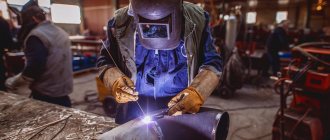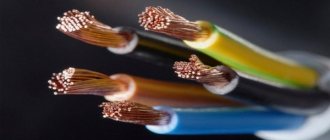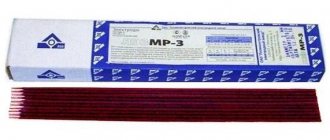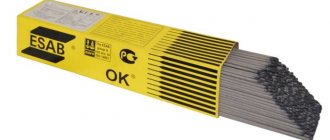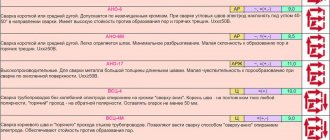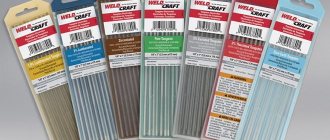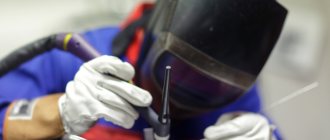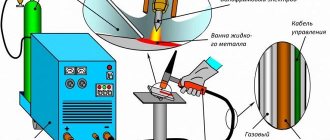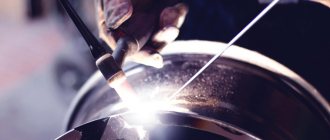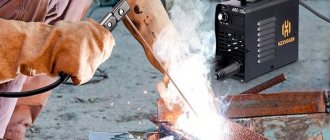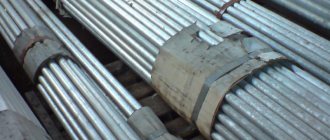In this article we will tell you how to choose the right tungsten electrode for argon arc welding, what types of tungsten there are, their distinctive properties, and how the composition affects the quality of the weld.
But at the very beginning, we would like to draw your attention to the fact that tungsten electrodes of the WL-15, WL-20, WC-20, WY-20 and WZ-8 brands have appeared in the range of PTK branded products.
Our tungsten electrodes have undergone X-ray microanalysis of elemental composition at the National Research Institute. We conducted this paid study on our own initiative in order to demonstrate to dealers and consumers the highest quality of our products.
The analysis was carried out on a Tescan Vega II scanning electron microscope, which allows you to obtain SEM images and analyze the elemental composition in real time, which is necessary for quality control of products and materials.
You can familiarize yourself with the research protocols and the results of the elemental composition of tungsten electrodes produced by PTK in the reporting documents.
What is a tungsten electrode and where is it used?
A tungsten electrode is a round rod made of pure tungsten or tungsten with the addition of additives (alloying additives). Tungsten is used in TIG welding with a non-consumable electrode.
If you have a question, why “non-melting”, then the answer is very simple. Tungsten has the highest melting point among pure metals (3422°C). Therefore, argon arc welding is performed with straight polarity, because the temperature of the cathode spot (-) reaches 3000 °C, and the temperature of the anode spot (+) reaches 4000 °C. Because of this, the electrode is not consumed during welding, but burns out.
Electrodes can have a clean or polished surface. A distinctive feature of clean electrodes is that they are chemically cleaned, i.e. The workpieces are etched to remove oxides and contaminants from the surface.
This is the most labor-intensive and costly procedure, therefore it is used much less frequently in industrial production. The ground surface of the electrodes suggests that the electrodes may have been processed by forging, broaching, or centerless grinding. The latter method is the most popular; as a result of this manufacturing, the thermal conductivity of the electrodes improves.
The diameter and length of tungsten electrodes can vary. Standard electrodes have a length from 50 to 175 mm, and a nominal diameter from 0.5 to 10 mm. In Russia, electrodes are manufactured according to GOST 23949-80, TU 48-19-27-91, TU 48-19-39-85, 48-19-221-83 and TU 48-19-527-83 from pure tungsten and tungsten with activating alloying additives of rare earth metals.
Tungsten electrodes are used exclusively in TIG welding, due to the prevention of oxides on the surface of the connecting seam. Welding occurs in a shielding gas environment, which protects the welding zone from exposure to oxygen.
This type of welding uses a chemically inert gas (noble gas). These gases include helium, argon and special welding mixtures. A distinctive feature of these gases is that they have very low chemical reactivity, in other words, they do not interact with the metal of the weld. These gases are also colorless and odorless.
Tungsten welding using an inverter
To work with tungsten electrodes, a universal source of electrical energy is used - an inverter. Less common are the use of welding rectifiers (for direct current only) and transformers (for alternating electricity). The inverter is in demand, due to its practicality, for working with two types of welding voltage.
Approximate cost of inverters for welding on Yandex.market
Inverter welding equipment
For this type of welding you need:
- welding inverter;
- burner;
- argon;
- non-consumable electrode;
- filler wire;
- oscillator;
- personal protective equipment (mask, gloves for argon arc welding, overalls).
Scheme of argon arc welding
A welding torch is used to rigidly fix the tungsten electrodes in the required position. It supplies current and evenly distributes the supply of argon around the weld pool.
Shielding gas is used primarily to displace air from the welding area and to remove its contact with the working rod. Argon or helium also ensures the passage of current and heat transfer through the arc. The choice of specific gas type depends on the material being welded.
An important condition for a high-quality final seam is the initial preparation of the edges of the part.
Welding technique
For manual welding using an inverter, the following rules must be followed:
- Welding occurs from right to left.
- For products with small thickness, the burner is positioned at an angle of 60°.
- For thick parts, the burner is placed at an angle of 90°.
- The method of guiding the filler wire depends on the thickness of the metal being welded.
The most important condition for a high-quality weld is a stable arc. This can be achieved using direct current with straight polarity. Sharpening the non-melting rod is also important. During the sharpening process, it is necessary to ensure that the electrode does not overheat, in which case the rod becomes brittle during welding.
The filler wire is not inserted into the center of the arc, but slightly to the side with a reciprocating movement, if the metal thickness is up to 10 mm. To weld metals with greater thickness, the wire is moved in translational and transverse movements.
Alphanumeric marking of tungsten electrodes
In Russia, 2 types of marking of tungsten electrodes can be used and applied - this is the classification according to GOST, TU and the international classification according to ISO 6848. Let us briefly consider these types of markings.
Marking of domestic electrodes according to GOST and TU
Products that are manufactured in Russia and comply with the established GOST and TU contain the letters “E” and “B” in their name; they come first in the name and mean “tungsten electrode.” Further, the name indicates the chemical composition of the additives and their mass fraction.
- EHF - “H” - pure (tungsten not less than 99.92%);
- EVL - “L” - lanthanum (mass fraction of lanthanum oxide from 1.1 to 1.4%);
- EVL-2 - “L” - lanthanum (mass fraction of lanthanum oxide from 1.4 to 1.6%)
- EVI-1 - “I” - yttrium (mass fraction of yttrium oxide from 1.5 to 2.3%)
- EVI-2 - “I” - yttrium (mass fraction of yttrium oxide from 2.0 to 3.0% and tantalum 0.1%)
- EVI-3 - “I” - yttrium (mass fraction of yttrium oxide from 2.5 to 3.5% and tantalum 0.1%);
- EVT-15 - “T” - thorium (mass fraction of thorium dioxide from 1.5 to 2.0%).
International marking according to ISO 6848 standards
Most tungsten alloys have been standardized by the International Organization for Standardization in ISO 6848. The table below shows the alphanumeric designations and percentage composition of alloying additives.
| Letter designation | Color code | Mass fraction of alloying additives |
| W.P. | Green | – |
| WC-20 | Grey | ~2% |
| WL-10 | Black | ~1% La₂O₃ |
| WL-15 | Gold | ~1.5% La₂O₃ |
| WL-20 | Blue | ~2% La₂O₃ |
| WT-10 | Yellow | ~1% ThO₂ |
| WT-20 | Red | ~2% ThO₂ |
| WT-30 | Violet | ~3% ThO₂ |
| WT-40 | Orange | ~4% ThO₂ |
| WY-20 | Blue | ~2% Y₂O₃ |
| WZ-3 | Brown | ~0.3% ZrO₂ |
| WZ-8 | White | ~0.8% ZrO₂ |
What are alloying additives and rare earth metals?
We have looked at the alphanumeric designations of tungsten electrodes, now it’s time to talk about the rare earth metals (elements) that are part of the electrodes, or rather, alloying additives (additives).
Rare earth metals are a group of 17 elements that include scandium, yttrium, lanthanum and lanthanides. All these metals are silvery-white in color, similar in chemical and physical properties, and form refractory oxides that are practically insoluble in water.
These metals received the name “rare earth” due to the fact that they are rarely found in the earth’s crust, and these metals are also difficult to mine and industrially produce.
The most commonly used additives in tungsten welding electrodes are lanthanum, cerium, yttrium, zirconium and thorium.
Tungsten as a welding material
This element belongs to metals. It is the most refractory, very hard and brittle, its melting point is almost 35,000 C. The electrode contains tungsten itself from 95% to 99.5%. The rest comes from other additives - oxides of thorium, cerium, lanthanum, zirconium, yttrium. The listed oxides are introduced into the rod based on the purpose of a specific brand.
Purpose
The main purpose of this electrode is welding special steels, aluminum, magnesium and various light alloys, refractory metals and metals of small thickness, for work where very strict requirements are imposed.
Properties of filler metals and their influence on the quality of the weld
Tungsten Electrode WP (Green)
Pure tungsten electrodes are classified as WP and have a green color code. The tungsten content in them is at least 99.5%.
- Features: Electrodes marked WP provide high arc stability, but have poor heat resistance and electronic emission. Due to this limited thermal load, the working end of the electrode must be sharpened into a round shape (ball).
- Current type: Designed for welding with sinusoidal current (AC) in argon or helium.
- Metal: This type of electrode is designed for welding aluminum, magnesium, nickel and their alloys.
Due to the fact that WP electrodes were used on transformer equipment, and now most welding equipment is inverter, the need for such electrodes has decreased significantly, so these electrodes are not in the PTK range.
Tungsten electrodes WL-10 (black), WL-15 (gold) and WL-20 (blue)
WL-10 is a lanthanum oxide (La₂O₃) electrode, color code black. The mass fraction of lanthanum oxide reaches up to 1%.
WL-15 is a lanthanum oxide (La₂O₃) electrode, gold color code. The mass fraction of lanthanum oxide varies from 1.4 to 1.6%.
WL-20 is an electrode containing lanthanum oxide (La₂O₃), the mass fraction of which reaches up to 2.2%. The electrode color code is blue.
- Features: These are universal electrodes that can withstand high current loads, improve arc stability and ease of starting while reducing burnout. Lanthanum electrodes are less likely to contaminate the seam with tungsten, which is especially important during finishing work. They also retain the sharpness of the working end for a long time.
- Current type: Electrodes can be used for direct and alternating current (AC/DC) welding.
- Metal: Used for welding carbon and alloy steels, aluminum, titanium, nickel, copper and magnesium alloys.
The range of PTK branded products includes tungsten electrodes WL-15 with a diameter from 1.6 to 4.0 mm and WL-20 with a diameter from 1.0 to 4.0 mm.
Scope of application in welding production
It is good to work with a tungsten electrode when working with metal with a thickness of 0.1 to 6 mm. It is allowed to work without additives, with a wall thickness of no more than 2 mm. The seam is formed by molten edges. Thicker metal requires filler material in the form of filler wire or plates, which are fed into the arc zone or laid in the groove. Butt and fillet welds in any position in space are performed automatically, semi-automatically or manually. The most important condition for work is to protect the weld pool from exposure to air. Therefore, the welding process with tungsten is carried out in protection from inert gases (most often argon), and this type of welding is called argon-arc welding. Argon is an inert gas. This means that it does not react with the molten metal, and since argon is heavier than air, it displaces it and reliably protects the bath. It is necessary that the entire weld pool, the end of the filler and the electrode itself be protected by argon.
Preparation and assembly of edges
In order for the quality of welding to be ensured reliably, especially when the structure is thin-sheet, it is necessary to carry out correct and precise preparation, preliminary assembly and tack welding of edges in assembly and welding fixtures.
Cleanliness of the connection
Particular attention should be paid to the cleanliness of the joint being welded and the working part of the rod itself. If the end of the electrode is dirty or burnt, the edges of the joint are not cleaned, there is a danger of a piece of tungsten getting into the bath and forming a harmful inclusion in the weld structure. To avoid unnecessary contact of the electrode with the metal surface, an oscillator is used - a device for contactless initiation of the arc.
Welding mode
It is imperative to strictly observe the welding regime, that is, select the current strength, monitor gas consumption, observe the electrode feed rate along the seam - this is the key to the quality of the connection.
Features of welding with tungsten electrodes The main feature of tungsten is its high melting point. And in combination with inert argon protection, these electrodes simply work welding miracles! Suffice it to say that the thickness range ranges from tenths of a millimeter to tens of millimeters, the current strength can be from several amperes to hundreds of amperes. There is no metal, steel or alloy in nature that cannot be welded using argon-arc welding. In recent years, along with artistic forging, artistic argon welding and artist-welders have become increasingly popular.
Some mandatory technological requirements: When manual welding, the following requirements must be observed: • movement is from right to left; • when working with products up to 2-2.5 mm thick, the burner must be held at an angle of 60 degrees to the surface of the product, and when the thickness of the parts is more than 2-2.5 mm, the angle should be adjusted to approximately 90 degrees. Transverse vibrations are not recommended. If the process takes place in automatic or semi-automatic mode, then the bar is directed so that it moves ahead of the arc.
Tungsten electrode PTK WL-15
Article: 007.100.117 Tungsten electrode PTK WL-15-175mm Ø 4.0
The WL-15 electrode containing lanthanum oxide is used in alternating and direct current for welding aluminum, carbon and stainless steels. Electrode diameter 4.0 mm, length – 175 mm. Supplied in a plastic pack of 10 pieces.
Price: 653 RUR
Article: 007.100.116 Tungsten electrode PTK WL-15-175mm Ø 3.2
The WL-15 electrode containing lanthanum oxide is used in alternating and direct current for welding aluminum, carbon and stainless steels. Electrode diameter 3.2 mm, length – 175 mm. Supplied in a plastic pack of 10 pieces.
Price: 485 RUR
Article: 007.100.115 Tungsten electrode PTK WL-15-175mm Ø 3.0
The WL-15 electrode containing lanthanum oxide is used in alternating and direct current for welding aluminum, carbon and stainless steels. Electrode diameter 3.0 mm, length – 175 mm. Supplied in a plastic pack of 10 pieces.
Price: 376 RUR
Article: 007.100.114 Tungsten electrode PTK WL-15-175mm Ø 2.4
The WL-15 electrode containing lanthanum oxide is used in alternating and direct current for welding aluminum, carbon and stainless steels. Electrode diameter 2.4 mm, length – 175 mm. Supplied in a plastic pack of 10 pieces.
Price: 278 RUR
Article: 007.100.113 Tungsten electrode PTK WL-15-175mm Ø 2.0
The WL-15 electrode containing lanthanum oxide is used in alternating and direct current for welding aluminum, carbon and stainless steels. Electrode diameter 2.0 mm, length – 175 mm. Supplied in a plastic pack of 10 pieces.
Price: 190 RUR
Article: 007.100.112 Tungsten electrode PTK WL-15-175mm Ø 1.6
The WL-15 electrode containing lanthanum oxide is used in alternating and direct current for welding aluminum, carbon and stainless steels. Electrode diameter 1.6 mm, length – 175 mm. Supplied in a plastic pack of 10 pieces.
Price: 122 RUR
Tungsten electrode PTK WL-20
Article: 007.100.127 Tungsten electrode PTK WL-20-175mm Ø 4.0
The WL-20 electrode with a lanthanum oxide content of up to 2.2% is used for welding aluminum, carbon and stainless steels at maximum currents. Suitable for alternating and direct current. Electrode diameter 4.0 mm, length – 175 mm. Supplied in a plastic pack of 10 pieces.
Price: 790 RUR
Article: 007.100.126 Tungsten electrode PTK WL-20-175mm Ø 3.2
The WL-20 electrode with a lanthanum oxide content of up to 2.2% is used for welding aluminum, carbon and stainless steels at maximum currents. Suitable for alternating and direct current. Electrode diameter 3.2 mm, length – 175 mm. Supplied in a plastic pack of 10 pieces.
Price: 500 RUR
Article: 007.100.125 Tungsten electrode PTK WL-20-175mm Ø 3.0
The WL-20 electrode with a lanthanum oxide content of up to 2.2% is used for welding aluminum, carbon and stainless steels at maximum currents. Suitable for alternating and direct current. Electrode diameter 3.0 mm, length – 175 mm. Supplied in a plastic pack of 10 pieces.
Price: 441 RUR
Article: 007.100.124 Tungsten electrode PTK WL-20-175mm Ø 2.4
The WL-20 electrode with a lanthanum oxide content of up to 2.2% is used for welding aluminum, carbon and stainless steels at maximum currents. Suitable for alternating and direct current. Electrode diameter 2.4 mm, length – 175 mm. Supplied in a plastic pack of 10 pieces.
Price: 289 RUR
Article: 007.100.123 Tungsten electrode PTK WL-20-175mm Ø 2.0
The WL-20 electrode with a lanthanum oxide content of up to 2.2% is used for welding aluminum, carbon and stainless steels at maximum currents. Suitable for alternating and direct current. Electrode diameter 2.0 mm, length – 175 mm. Supplied in a plastic pack of 10 pieces.
Price: 197 RUR
Article: 007.100.122 Tungsten electrode PTK WL-20-175mm Ø 1.6
The WL-20 electrode with a lanthanum oxide content of up to 2.2% is used for welding aluminum, carbon and stainless steels at maximum currents. Suitable for alternating and direct current. Electrode diameter 1.6 mm, length – 175 mm. Supplied in a plastic pack of 10 pieces.
Price: 125 RUR
Article: 007.100.121 Tungsten electrode PTK WL-20-175mm Ø 1.0
The WL-20 electrode with a lanthanum oxide content of up to 2.2% is used for welding aluminum, carbon and stainless steels at maximum currents. Suitable for alternating and direct current. Electrode diameter 1.0 mm, length – 175 mm. Supplied in a plastic pack of 10 pieces.
Price: 62 rub.
Tungsten electrodes WC-10 (pink) and WC-20 (gray)
WC-10 is a cerium oxide (CeO₂) electrode, pink color code. The mass fraction of cerium oxide reaches up to 1%.
WC-20 is an electrode containing cerium oxide (CeO₂), the mass fraction of which varies from 1.8 to 2.2%. Has a gray color code.
- Features: Cerium as an alloying element improves arc stability and ease of starting while reducing burnout. Tungsten grade WC-10/20 is recommended for use in short welding cycles at low current values.
- Current type: Cerium electrodes are designed for welding with direct and alternating current (AC/DC).
- Metal: Electrodes are designed for welding aluminum, all types of steels and their alloys, especially thin sheets.
Only branded tungsten electrodes PTK WC-20 with a diameter of 1.6 to 3.2 mm are on sale.
Article: 007.100.134 Tungsten electrode PTK WS-20-175mm Ø 3.2
WC-20 electrode containing cerium oxide is used for welding aluminum, carbon and stainless steels. It is used for welding on alternating and direct current. Electrode diameter 3.2 mm, length – 175 mm. Supplied in a plastic pack of 10 pieces.
Price: 406 RUR
Article: 007.100.133 Tungsten electrode PTK WC-20-175mm Ø 2.4
WC-20 electrode containing cerium oxide is used for welding aluminum, carbon and stainless steels. It is used for welding on alternating and direct current. Electrode diameter 2.4 mm, length – 175 mm. Supplied in a plastic pack of 10 pieces.
Price: 230 RUR
Article: 007.100.132 Tungsten electrode PTK WC-20-175mm Ø 2.0
WC-20 electrode containing cerium oxide is used for welding aluminum, carbon and stainless steels. It is used for welding on alternating and direct current. Electrode diameter 2.0 mm, length – 175 mm. Supplied in a plastic pack of 10 pieces.
Price: 197 RUR
Article: 007.100.131 Tungsten electrode PTK WC-20-175mm Ø 1.6
WC-20 electrode containing cerium oxide is used for welding aluminum, carbon and stainless steels. It is used for welding on alternating and direct current. Electrode diameter 1.6 mm, length – 175 mm. Supplied in a plastic pack of 10 pieces.
Price: 125 RUR
Tungsten electrode WY-20 (blue)
This is a tungsten electrode containing yttrium oxide (Y₂O₃), which is color coded blue. The mass fraction of the alloying additive varies from 1.8 to 2.2%.
- Features: Yttrium tungsten electrodes can withstand high currents and, subject to welding technology, provide a high-quality and reliable seam, therefore they are especially suitable for welding particularly critical structures.
- Current type: Designed for direct current (DC) welding only.
- Metal: This type of electrode is suitable for welding all types of steels, titanium, copper and their alloys.
The range of WY-20 electrodes is presented in diameters of 1.6 / 2.0 / 2.4 and 3.2 mm.
Article: 007.100.144 Tungsten electrode PTK WY-20-175mm Ø 3.2
The WY-20 electrode containing yttrium oxide is used for welding structures made of carbon, low-alloy and stainless steels. Used when operating on direct current. Electrode diameter 3.2 mm, length – 175 mm. Supplied in a plastic pack of 10 pieces.
Price: 422 RUR
Article: 007.100.143 Tungsten electrode PTK WY-20-175mm Ø 2.4
The WY-20 electrode containing yttrium oxide is used for welding structures made of carbon, low-alloy and stainless steels. Used when operating on direct current. Electrode diameter 2.4 mm, length – 175 mm. Supplied in a plastic pack of 10 pieces.
Price: 273 RUR
Article: 007.100.142 Tungsten electrode PTK WY-20-175mm Ø 2.0
The WY-20 electrode containing yttrium oxide is used for welding structures made of carbon, low-alloy and stainless steels. Used when operating on direct current. Electrode diameter 2.0 mm, length – 175 mm. Supplied in a plastic pack of 10 pieces.
Price: 165 RUR
Article: 007.100.141 Tungsten electrode PTK WY-20-175mm Ø 1.6
The WY-20 electrode containing yttrium oxide is used for welding structures made of carbon, low-alloy and stainless steels. Used when operating on direct current. Electrode diameter 1.6 mm, length – 175 mm. Supplied in a plastic pack of 10 pieces.
Price: 118 RUR
Tungsten electrodes WZ-3 (brown) and WZ-8 (white)
WZ-3 is a zirconium oxide (ZrO₂) electrode, color code brown. The mass fraction of cerium oxide reaches up to 0.3%.
WZ-8 is an electrode containing zirconium oxide (ZrO₂), the mass fraction of which varies from 0.7 to 0.9%. Has a white color code.
- Features: This type of electrodes can be used when welding at high currents. They have poor arc stability and are very demanding on the cleanliness of the weld pool. It is recommended to sharpen the working end of these electrodes in the shape of a hemisphere.
- Current type: Designed for welding on alternating current (AC) only.
- Metal: Electrodes are designed for welding aluminum, magnesium, nickel, bronze and their alloys.
Only branded tungsten electrodes PTK WZ-8 with diameters of 1.6 / 2.0 / 2.4 and 3.2 mm are on sale.
Article: 007.100.154 Tungsten electrode PTK WZ-8-175mm Ø 3.2
The WZ-8 electrode containing zirconium oxide is used when operating on alternating current for welding aluminum, bronze, nickel and their alloys. Electrode diameter 3.2 mm, length – 175 mm. Supplied in a plastic pack of 10 pieces.
Price: 500 RUR
Article: 007.100.153 Tungsten electrode PTK WZ-8-175mm Ø 2.4
The WZ-8 electrode containing zirconium oxide is used when operating on alternating current for welding aluminum, bronze, nickel and their alloys. Electrode diameter 2.4 mm, length – 175 mm. Supplied in a plastic pack of 10 pieces.
Price: 283 RUR
Article: 007.100.152 Tungsten electrode PTK WZ-8-175mm Ø 2.0
The WZ-8 electrode containing zirconium oxide is used when operating on alternating current for welding aluminum, bronze, nickel and their alloys. Electrode diameter 2.0 mm, length – 175 mm. Supplied in a plastic pack of 10 pieces.
Price: 197 RUR
Article: 007.100.151 Tungsten electrode PTK WZ-8-175mm Ø 1.6
The WZ-8 electrode containing zirconium oxide is used when operating on alternating current for welding aluminum, bronze, nickel and their alloys. Electrode diameter 1.6 mm, length – 175 mm. Supplied in a plastic pack of 10 pieces.
Price: 125 RUR
Tungsten electrodes WT
WT brand electrodes are doped with thorium oxide (ThO₂) and include the following varieties:
- WT-10 - yellow color code, thorium dioxide content up to 1%;
- WT-20 - red color code, thorium dioxide content up to 2%;
- WT-30 - purple color code, thorium dioxide content up to 3%;
- WT-40 - orange color code, thorium dioxide content up to 4%.
Tungsten electrodes made of thorium oxide alloy are used in direct current (DC) welding of stainless steel, copper, nickel, titanium and their alloys.
An important and distinctive feature of thorium is its radioactivity. Thorium is considered a radioactive metal, making inhalation of fumes and dust a health risk to the welder and disposal an environmental risk. Based on these considerations, there are no WT thorium tungsten electrodes in the range of PTK branded products.
Marking and decoding
For the convenience of welders and to minimize errors in the selection of consumables, non-consumable electrodes are divided into categories that have specific markings.
The Latin letter “W” indicates that the product belongs to the category of tungsten electrodes. After this, a ligature is prescribed - additions and additives that provide improved welding characteristics. These can be symbols:
- WP - pure tungsten (99.5%);
- Z – zirconium oxide added;
- T – thorium dioxide added;
- C - cerium added;
- Y – yttrium dioxide added;
- L – added lanthanum oxide.
The numbers in front of the letters indicate the percentage of a certain ligature, as well as the length of the wire used as the core.
Color marking of non-consumable consumables is also actively used.
- White products are WZ-8, the composition of which contains 0.8% zirconium oxide. They are designed for use with alternating current and are equipped with a ball-shaped tip. These rods are used to work with magnesium and aluminum, bronze and nickel, as well as composites based on these metals.
- Green WP electrodes function perfectly in protective gas environments. They are used for welding parts made of aluminum and magnesium.
- Gray color indicates universal consumables WC-20, which contain 2% cerium oxide. When using them, the welding arc starts at low currents, simplifying work with rolled pipes and thin-sheet workpieces, and allowing the formation of structures made of titanium, tantalum, etc.
- Blue and gold WL-15 models contain about 2 percent cerium, which significantly increases the operating current. Therefore, such consumables are distinguished by simple arc ignition, clean welded joints and halved core wear. They are suitable for welding copper, aluminum and bronze workpieces, as well as high alloy steels.
- Dark blue WY-20 consumables contain yttrium in a volume of about 1.8-2.2 percent. They are used for welding work with stainless, low-carbon and carbon steels, as well as with copper and titanium alloys.
- Thorium oxide rods (WT-20) are red in color and are designed to operate with direct current, demonstrating minimal material consumption. Similar products are used when welding various non-ferrous metals.
Recommendations for selecting electrode diameter and welding current
The quality of the weld directly depends on the correctly selected diameter of the welding electrode and the set current. Therefore, we have prepared special recommendations for you that will help you achieve the highest quality results in the welding process.
| Electrode diameter, mm | Recommended current for welding in argon (AC), A | Recommended current for welding in helium (AC), A | Recommended current for welding in argon (DC), A | Recommended current when welding in helium (DC), A |
| 1,0 | up to 60 | up to 50 | up to 70 | up to 50 |
| 1,6 | 60–120 | 50–110 | 70–120 | 50–100 |
| 2,0 | 70–130 | 60–120 | 90–150 | 70–130 |
| 2,4 | 100–180 | 90–160 | 110–180 | 90–150 |
| 3,0 | 140–230 | 120–200 | 150–220 | 120–200 |
| 3,2 | 160–250 | 150–220 | 180–270 | 160–250 |
| 4,0 | 200–320 | 180–300 | 200–350 | 180–320 |
Welding calculator for TIG welding
We remind you that we have developed a specialized TIG welding calculator that will be useful to dealers and welders who are just learning the basics of argon arc welding. The calculator will “give” recommendations for welding work with aluminum, steel and stainless steel, possibly with the choice of torches and components. The choice of thickness of the welded metal is from 1 to 12 mm. Also, the calculator will tell you which areas need to be welded, depending on the type of connection.
Follow the link and use the TIG calculator.
Rules for argon arc welding
To carry out proper welding, the following rules must be observed:
- Use special assembly and welding devices when working with thin metal sheets. They will help you connect the edge precisely, and you will get a thin and strong weld.
- The electrodes must be perfectly clean at the ends to obtain a high-quality seam.
- Before welding, it is necessary, according to all the rules and observing all the requirements, to determine the current strength. This will ensure low material consumption and the duration of the sharpening form.
- Try not to let air into the welding area, otherwise you risk getting a poor-quality seam.
By following all the rules and having the necessary knowledge to carry out welding work, you will be able to make a high-quality seam and provide yourself with decades of a quiet life. You don't have to patch holes, because impeccably done work can maintain its original qualities for many years.
